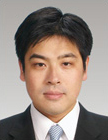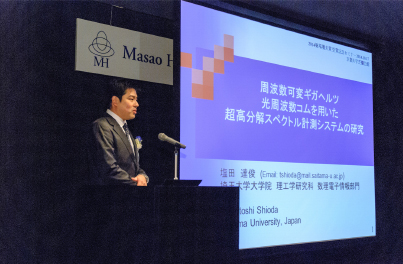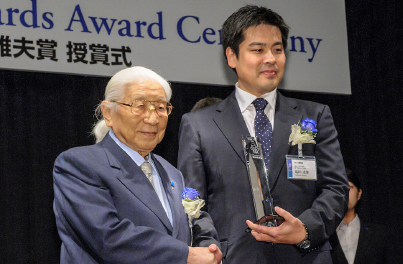

Study of high-resolution spectroscopy using frequency tunable gigahertz optical frequency comb
Dept. of Electrical and Electronic Systems, Saitama University
*The organization and the title are those when awarded
Abstract
- 日本語
- English
周波数軸上に精密に等しい間隔にピークが整列した光周波数コムと周波数掃引可能な単側波帯(SSB: Single-Sideband)光変調器により高分解分光システムを開発した。本システムは1 MHzの精度と絶対周波数で波長走査できる光周波数コムを光源と、ヘテロダイン検波による検出部を備える。その精度は、波長安定化した種光としての周波数安定化光源とSSB光変調器により保証される。光検出部では、光周波数コムを構成する個々のピーク強度は光ヘテロダイン検波により検出する。また、計測できる周波数範囲は光周波数コムの広い帯域を利用することができる。実験では1 MHz線幅の光共振器とH13C14Nガスを用いて実証実験を行った。
High-resolution spectroscopy based on a single-sideband (SSB) optical modulator combined with an optical frequency comb was proposed. A frequency tunable comb was developed with a spectral resolution of less than 1 MHz on the absolute frequency axis ensured by the combination of the SSB optical modulator and frequency-locked laser diode. Also, the measurement frequency range was determined by the frequency band of an optical frequency comb, in which the peak intensity was individually measured by the optical heterodyne detection method. The performance was experimentally confirmed using a 1-MHz-width resonator and a H13C14N gas cell.
Research summary
Optical spectroscopy is a powerful technique for the material investigation. By increasing both the range and the sampling pitch of the light frequency, it becomes possible to measure a wider variety of materials at greater detail. Recently, an optical frequency comb* has drawn attention as an attractive technique to achieve such a measurement. In conventional spectroscopy, the optical frequency comb has discrete and constant frequencies which limit the measurement frequencies.
Dr. Shioda developed a novel technique which is used to broaden the frequency interval of the comb about one hundred times over a conventional comb. This is accomplished by adopting a different generation mechanism for the optical frequencies. In addition, all the frequencies lying in the comb teeth intervals can be exploited by applying a method used in the field of optical communication which enables to change the frequencies continuously. This new technique enables spectroscopic measurements with broader frequency range and narrower frequency pitch.
This technological innovation will facilitate real time analysis of complicated gas mixtures such as automobile exhausts and industrial processes.
* Optical frequency comb consists of a light source of various frequency components with very precise frequency intervals. The name comes from the comb-like appearance where the discrete frequencies resemble the teeth on a comb. This technique was awarded the 2005 Nobel Prize in physics as a promising technique for applications requiring precise spectroscopic measurements.



